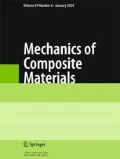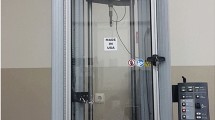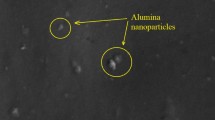The effect of Al2O3 and B4C nanoparticles on the quasi-static penetration test (QSPT) and Charpy impact test of glass-fiber-reinforced polymer composite plates has been studied with the aim to clear up whether there is a correlation between results of these two tests. Punch shear tests on the plates were carried out. The data for the absorbed energy obtained from the Charpy impact test were feasible to predict whether fiber-reinforced polymer nanocomposites will give positive results in the QSPT or ballistic tests. The predominant damage mechanisms were delamination and fiber break during the QSPT. Addition of 1 wt.% Al2O3 nanoparticles to the composite increased its punch shear strength by 8.97%, but the addition of B4C nanoparticles raised its hardness. It was also found that neither Al2O3 nor B4C increased the amount of absorbed energy.









Similar content being viewed by others
Change history
23 November 2021
A Correction to this paper has been published: https://doi.org/10.1007/s11029-021-09991-w
References
M. Özen, G. Demircan, M. Kisa, and Z. Ilik, “Investigation of usability of waste textile fabrics in composites,” Emerg. Mater. Res., 9, No. 1, 1-6 (2020).
D. K. Rajak, D. D. Pagar, P. L. Menezes, and E. Linul, “Fiber-reinforced polymer composites: Manufacturing, properties, and applications,” Polymers, 11, No. 10, 1667 (2019).
F. A. Shishevan, H. Akbulut, and M. A. Mohtadi-Bonab, “Low velocity ımpact behavior of basalt fiber-reinforced polymer composites,” J. Mater. Eng. Perform, 26, No. 6, 2890-2900 (2017).
W. L. Lai, H. Saeedipour, and K. L. Goh, “Mechanical properties of low-velocity ımpact damaged carbon fibre reinforced polymer laminates: Effects of drilling holes for resin-ınjection repair,” Compos. Struct., 235, 111806 (2020).
J. Liu, H. Liu, C. Kaboglu, X. Kong, Y. Ding, H. Chai, B. R. K. Blackman, A. J. Kinloch, and J. P. Dear, “The ımpact performance of woven-fabric thermoplastic and thermoset composites subjected to high-velocity soft- and hard-ımpact loading,” Appl. Compos. Mater., 26, No. 5-6, 1389-1410 (2019).
A. Shimamoto, R. Kubota, and K. Takayama, “High-velocity ımpact characteristic of carbon fiber reinforced plastic composite at low temperature,” J. Strain Anal. Eng. Des., 47, No. 7, 471-479 (2012).
N. Domun, C. Kaboglu, K. R. Paton, J. P. Dear, J. Liu, B. R. K. Blackman, G. Liaghat, and H. Hadavinia, “Ballistic ımpact behaviour of glass fibre reinforced polymer composite with 1D/2D nanomodified epoxy matrices,” Composites, Part B., 167, 497-506 (2019).
J. Naveen, M. Jawaid, E. S. Zainudin, M. T. H. Sultan, and R. Yahaya, “Evaluation of ballistic performance of hybrid kevlar®/cocos nucifera sheath reinforced epoxy composites,” J. Text. Inst., 110, No. 8, 1179-1189 (2019).
Y. Li, W. Zhang, Z. Yang, J. Zhang, and S. Tao, “Low-velocity ımpact damage characterization of carbon fiber reinforced polymer (CFRP) using ınfrared thermography,” Infrared Phys. Technol., 76, 91-102 (2016).
J. I. Margem, F. M. Margem, M. R. Margem, V. A. Gomes, and S. N. Monteiro, “Charpy ımpact tests in epoxy matrix composites reinforced with malva fibers,” In: The Minerals, Metals & Materials Society (eds) TMS 2014: 143rd Annual Meeting & Exhibition, 425-432 (2014).
P. Wagner, “The dynamics of ımpact on composite structures,” Key Eng. Mater., 141, 671-694 (1997).
M. A. Abtew, F. Boussu, P. Bruniaux, C. Loghin, and I. Cristian, “Ballistic ımpact mechanisms — A review on textiles and fibre-reinforced composites ımpact responses,” Compos. Struct., 223, 110966 (2019).
A. Shahkaramı, E. Cepus, R. Vazırı, and A. Poursartıp, Material Responses to Ballistic Impact, Lightweight Ballistic Composites, Woodhead Publishing, New York, USA, 72-100 (2006).
C. T. Sun and S. V. Potti, “A simple model to predict residual velocities of thick composite laminates subjected to high velocity ımpact,” Int. J. Impact Eng., 18, No. 3, 339-353 (1996).
B. A. Gama and J. W. Gillespie, “Punch shear based penetration model of ballistic ımpact of thick-section composites,” Compos. Struct., 86, No. 4, 356-369 (2008).
J. B. Jordan, C. J. Naito, and B. Z. Haque, “Quasi-static, low-velocity ımpact and ballistic ımpact behavior of plain weave E-glass/Phenolic Composites,” J. Compos. Mater., 48, No. 20, 2505-2516 (2014).
B. Gu and X. Ding, “A refined quasi-microstructure model for finite element analysis of three-dimensional braided composites under ballistic penetration,” J. Compos. Mater., 39, No. 8, 685-710 (2005).
S. T. Jenq, H. S. Jing, and C. Chung, “Predicting the ballistic limit for plain woven glass/epoxy composite laminate,” Int. J. Impact Eng., 15, No. 4, 451-464 (1994).
W. Goldsmith, C. K. H. Dharan, and H. Chang, “Quasi-static and ballistic perforation of carbon fiber laminates,” Int. J. Solids Struct., 32, No. 1, 89-103 (1995).
C. Lin and M. S. H. Fatt, “Perforation of composite plates and sandwich panels under quasi-static and projectile loading,” J. Compos. Mater., 40, No. 20, 1801-1840 (2006).
M. Nagai and H. Miyairi, “The study on Charpy ımpact testing method of CFRP,” Adv. Compos. Mater., 3, No. 3, 177-190 (1994).
G. Simeoli, L. Sorrentino, F. Touchard, D. Mellier, M. Oliviero, and P. Russo, “Comparison of falling dart and charpy ımpacts performances of compatibilized and not compatibilized polypropylene/woven glass fibres composites,” Composites, Part B., 165, 102-108 (2019).
A. C. Pereira, S. N. Monteiro, F. S. de Assis, F. M. Margem, F. S. da Luz, and F. de O. Braga, “Charpy ımpact tenacity of epoxy matrix composites reinforced with aligned jute fibers,” J. Mater. Res. Technol., 6, No. 4, 312-316 (2017).
G. O. Glória, F. M. Margem, C. G. D. Ribeiro, Y. M. de Moraes, R. B. da Cruz, F. de A. Silva, and S. N. Monteiro, “Charpy ımpact tests of epoxy composites reinforced with giant bamboo fibers,” Mater. Res., 18, 178-184 (2015).
J. J. Andrew, S. M. Srinivasan, A. Arockiarajan, and H. N. Dhakal, “Parameters ınfluencing the ımpact response of fiber-reinforced polymer matrix composite materials: A critical review,” Compos. Struct., 224, 111007 (2019).
N. A. Rahman, A. Hassan, R. Yahya, and R. A. Lafia-Araga, “Impact properties of glass-fiber/polypropylene composites: The ınfluence of fiber loading, specimen geometry and test temperature,” Fibers Polym., 14, No. 11, 1877-1885 (2013).
L. F. C. Nascimento, S. N. Monteiro, L. H. L. Louro, F. S. da Luz, J. L. dos Santos, F. D. O. Braga, and R. L. S. B. Marçal, “Charpy ımpact test of epoxy composites reinforced with untreated and mercerized mallow fibers,” J. Mater. Res. Technol., 7, No. 4, 520-527 (2018).
S. Safi, A. Zadhoush, and M. Ahmadi, “Flexural and Charpy ımpact behaviour of epoxy/glass fabric treated by nano-SiO2 and silane blend,” Plast. Rubber Compos., 46, No. 7, 314-321 (2017).
A. Mohanty and V. K. Srivastava, “Effect of alumina nanoparticles on the enhancement of ımpact and flexural properties of the short glass/carbon fiber reinforced epoxy based composites,” Fibers Polym., 16, No. 1, 188-195 (2015).
Ö. Y. Bozkurt, Ö. Özbek, and A. R. Abdo, “The effects of nanosilica on Charpy ımpact behavior of glass/epoxy fiber reinforced composite laminates,” Period. Eng. Nat. Sci., 5, No. 3, 322-327 (2017).
A. Afrouzian, H. M. Aleni, G. Liaghat, and H. Ahmadi, “Effect of nano-particles on the tensile, flexural and perforation properties of the glass/epoxy composites,” J. Reinf. Plast. Compos., 36, No. 12, 900-916 (2017).
M. H. Pol and G. H. Liaghat, “Studies on the mechanical properties of composites reinforced with nanoparticles,” Polym. Compos., 38, No. 1, 205-212 (2017).
S. Halder, P. K. Ghosh, M. S. Goyat, and S. Ray, “Ultrasonic dual mode mixing and ıts effect on tensile properties of SiO2-epoxy nanocomposite,” J. Adhes. Sci. Technol., 27, No. 2, 111-124 (2013).
P. K. Ghosh, K. Kumar, and N. Chaudhary, “Influence of ultrasonic dual mixing on thermal and tensile properties of MWCNTs-epoxy composite,” Composites, Part B., 77, 139-144 (2015).
ASTM D6264 / D6264M-17, Standard Test Method for Measuring the Damage Resistance of a Fiber-Reinforced Polymer-Matrix Composite to a Concentrated Quasi-Static Indentation Force, ASTM International, West Conshohocken, PA, 2017, www.astm.org
R. Yahaya, S. M. Sapuan, M. Jawaid, Z. Leman, and E. S. Zainudin, “Quasi-static penetration and ballistic properties of kenaf-aramid hybrid composites,” Mater. Des., 63, 775-782 (2014).
Y. Sun, R. Burgueño, W. Wang, and I. Lee, “Modeling and simulation of the quasi-static compressive behavior of Al/Cu hybrid open-cell foams,” Int. J. Solids Struct., 54, 135-146 (2015).
A. Rossoll, C. Berdin, P. Forget, C. Prioul, and B. Marini, “Mechanical aspects of the Charpy ımpact test,” Nucl. Eng. Des., 188, No. 2, 217-229 (1999).
EN ISO 179-1, Plastics—Determination of Charpy impact properties, Part 1: Non-instrumented impact test,” 2010.
M. R. Mansor, Z. Mustafa, S. H. S. M. Fadzullah, G. Omar, M. A. Salim, and M. Z. Akop, “Recent advances in polyethylene-based biocomposites,” Natural Fibre reinforced vinyl ester and vinyl polymer composites, Woodhead Publishing, New York, USA, pp. 71-96 (2018).
J. R. Xiao, B. A. Gama, and J. W. Gillespie, “Progressive damage and delamination in plain weave S-2 glass/SC-15 composites under quasi-static punch-shear loading,” Compos. Struct., 78, No. 2, 182-196 (2007).
A. J. G. Fernandes, W. F. de Amorim Jr., W. B. Filho, I. P. Guedes, A. L. Silva, and W. L. Porto, “Behavior of fiberglass polymer composites under ballistic ımpact and quasi-static punch shear tests,” Mater. Sci. Forum, 881, 300-306 (2016).
A. Fathy, A. Shaker, M. A. Hamid, and A. A. Megahed, “The effects of nano-silica/nano-alumina on fatigue behavior of glass fiber-reinforced epoxy composites,” Journal of Composite Materials, 51, 1667-1679 (2017).
M. Bulut, A. Erkliğ, and E. Yeter, “Hybridization effects on quasi-static penetration resistance in fiber reinforced hybrid composite laminates,” Composites, Part B., 98, 9-22 (2016).
K. E. Öksüz and Y. Şahin, “Microstructure and hardness characteristics of Al2O3-B4C particle-reinforced Cu matrix composites,” Acta Phys. Pol. A, 129, No. 4, 650-652 (2016).
D. Rosato and D. Rosato, Desıgn Parameter, Plastics Engineered Product Design, Elsevier, New York, USA, 161-197 (2003).
G. Demircan, M. Kisa, M. Ozen, and B. Aktas, “Surface-modified alumina nanoparticles-filled aramid fiber-reinforced epoxy nanocomposites: Preparation and mechanical properties,” Iran. Polym. J., 29, No. 3, 253-264 (2020).
A. B. Abdul-hussein, F. A. Hashim, and T. R. Kadhim, “Effect of nano powder on mechanical and physical properties of glass fiber reinforced epoxy composite,” Al-Khwarizmi Eng. J., 12, No. 3, 72-79 (2016).
A. A. Megahed, M. A. Agwa, and M. Megahed, “Improvement of hardness and wear resistance of glass fiber-reinforced epoxy composites by the ıncorporation of silica/carbon hybrid nanofillers,” Polym. Plast. Technol. Eng., 57, No. 4, 251-259 (2018).
G. Agarwal, A. Patnaik, and R. K. Sharma, “Thermo-mechanical properties and abrasive wear behavior of silicon carbide filled woven glass fiber composites,” Silicon, 6, No. 3, 155-168 (2014).
Author information
Authors and Affiliations
Corresponding author
Additional information
Russian translation published in Mekhanika Kompozitnykh Materialov, Vol. 57, No. 4, pp. 721-738, July-August, 2021. Russian DOI: 10.22364/mkm.57.4.08.
Rights and permissions
About this article
Cite this article
Demircan, G., Kisa, M., Ozen, M. et al. Quasi-Static Penetration Behavior of Glass-Fiber-Reinforced Epoxy Nanocomposites. Mech Compos Mater 57, 503–516 (2021). https://doi.org/10.1007/s11029-021-09973-y
Received:
Revised:
Published:
Issue Date:
DOI: https://doi.org/10.1007/s11029-021-09973-y




